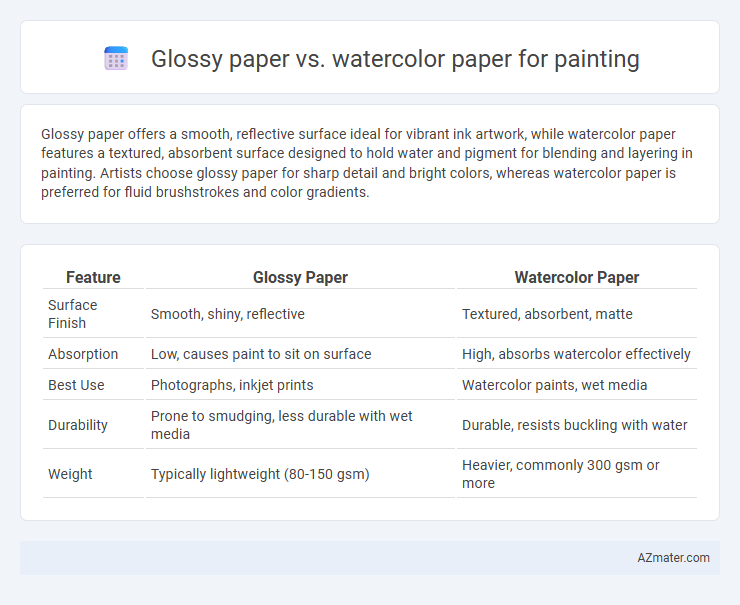Glossy paper offers a smooth, reflective surface ideal for vibrant ink artwork, while watercolor paper features a textured, absorbent surface designed to hold water and pigment for blending and layering in painting. Artists choose glossy paper for sharp detail and bright colors, whereas watercolor paper is preferred for fluid brushstrokes and color gradients.
Table of Comparison
| Feature | Glossy Paper | Watercolor Paper |
|---|---|---|
| Surface Finish | Smooth, shiny, reflective | Textured, absorbent, matte |
| Absorption | Low, causes paint to sit on surface | High, absorbs watercolor effectively |
| Best Use | Photographs, inkjet prints | Watercolor paints, wet media |
| Durability | Prone to smudging, less durable with wet media | Durable, resists buckling with water |
| Weight | Typically lightweight (80-150 gsm) | Heavier, commonly 300 gsm or more |
Introduction: Choosing the Right Paper for Painting
Glossy paper offers a smooth, reflective surface ideal for ink and marker artwork, but its non-absorbent finish can cause paint to pool and dry unevenly. Watercolor paper is specifically designed to handle water-based paints, featuring a textured surface that absorbs moisture and prevents warping or buckling. Selecting the right paper depends on the painting medium, desired texture, and drying behavior to achieve optimal artistic results.
Glossy Paper: Features and Characteristics
Glossy paper features a smooth, shiny surface ideal for vibrant, high-contrast artwork and photographic prints, enhancing color saturation and detail sharpness. Its non-porous coating prevents quick absorption of paints, requiring careful application to avoid smudging or uneven drying. Unlike watercolor paper, glossy paper lacks the texture and absorbency needed for water-based media, making it less suitable for traditional watercolor techniques but excellent for mixed media and digital print transfers.
Watercolor Paper: Features and Characteristics
Watercolor paper is specifically designed to absorb water and pigments, preventing warping and allowing for vibrant color blending and layering. It typically has a textured surface, such as cold press or rough, which enhances the paint's adherence and creates unique artistic effects. High-quality watercolor paper is usually made from 100% cotton fibers, offering durability and the ability to withstand multiple washes without degrading.
Suitability for Different Painting Techniques
Glossy paper offers a smooth, non-absorbent surface ideal for ink, markers, and acrylic paints, allowing vibrant colors and sharp details but less suited for heavy water washes. Watercolor paper, with its textured, absorbent fibers, excels in watercolor and gouache techniques by allowing water to blend and spread naturally without warping or buckling. Artists should select glossy paper for precision and bold colors, while watercolor paper is best for fluid, translucent washes and layered watercolor effects.
Absorption and Texture Comparison
Glossy paper features a smooth, reflective surface with low absorption, causing paint to sit on top and dry slowly, which can lead to smudging and limited blending. Watercolor paper offers high absorption and a textured surface, allowing paint to penetrate deeply and blend naturally, enhancing color vibrancy and control. The rough texture of watercolor paper also provides friction that helps retain pigment granules, crucial for techniques like wet-on-wet and layering.
Impact on Color Vibrancy and Blending
Glossy paper enhances color vibrancy by reflecting light, making paint hues appear more saturated and intense, while its smooth surface limits blending due to slower absorption of pigments. Watercolor paper, with its textured and porous surface, allows for better pigment absorption and seamless blending, resulting in softer transitions and a more natural diffusion of colors. The choice between glossy and watercolor paper directly impacts the visual effect of paint, with glossy prioritizing brightness and watercolor emphasizing smooth color gradients.
Durability and Longevity of Artwork
Glossy paper offers a smooth, reflective finish but tends to be less durable and more prone to surface damage over time compared to watercolor paper. Watercolor paper, made from high-quality cotton or cellulose fibers, provides superior durability and longevity, resisting warping and color fading even after prolonged exposure to moisture and light. Artists seeking archival-quality results often prefer watercolor paper for its ability to maintain the integrity and vibrancy of paint layers across decades.
Cost and Availability Considerations
Glossy paper generally costs less than watercolor paper and is widely available in standard stores and online, making it a budget-friendly choice for beginners and casual artists. Watercolor paper, often priced higher due to its specialized texture and weight, is available in various qualities and formats, catering to professional artists needing durability and pigment absorption. Choosing between glossy and watercolor paper depends on budget constraints and the desired painting technique, with watercolor paper favored for water-based mediums despite its higher cost and potentially limited availability in some retail locations.
Ideal Use Cases for Each Paper Type
Glossy paper is ideal for vibrant, detailed artworks such as ink or marker illustrations due to its smooth surface that enhances color saturation and sharpness. Watercolor paper is best suited for wet media like watercolor, gouache, or acrylics, offering superior absorbency and texture that prevents warping and allows for controlled paint flow. Artists choose glossy paper for crisp, polished finishes and watercolor paper for expressive, textured effects in fluid painting techniques.
Conclusion: Making the Best Choice for Your Art
Choosing between glossy paper and watercolor paper for painting depends on the desired texture and medium compatibility; glossy paper offers a smooth, reflective surface ideal for ink and marker work, while watercolor paper provides a textured, absorbent quality perfect for water-based paints. Artists seeking vibrant, controlled color application benefit from glossy paper's non-absorbent finish, whereas those aiming for fluid blending and rich pigment layering prefer watercolor paper's durability and weight. Evaluating the painting technique, medium, and finish will guide artists to select the most suitable paper to enhance their artwork's quality and longevity.

Infographic: Glossy paper vs Watercolor paper for Painting
 azmater.com
azmater.com